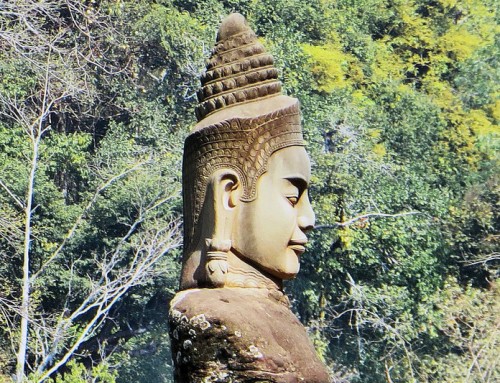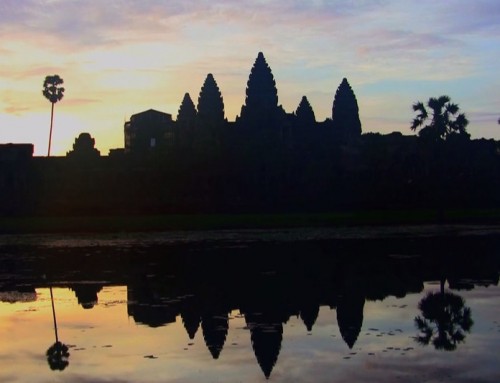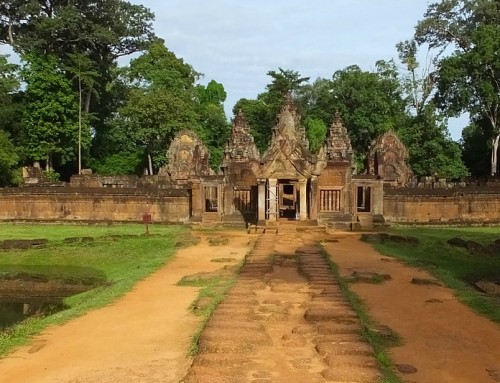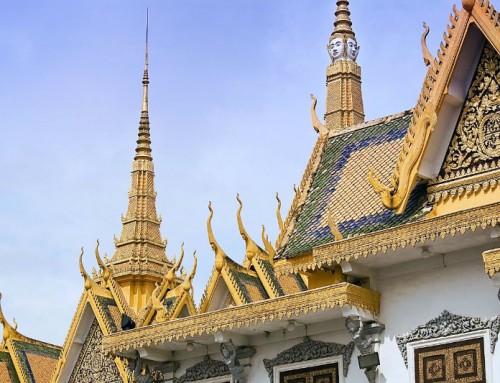
Day 01
Phnom Penh L, –
Arrival at Phnom Penh international airport and after immigration and customs formalities, meeting with the guide.
Transfer to hotel, where the check-in is generally provided at 14:00, however, if the rooms should be available before this time, guests will be accommodated as soon as possible.
Start the visit with the temple that gives the city its name, Wat Phnom: located atop a hill, attended by the faithful who come here to pray and get to predict the future by many fortune-tellers.
Then proceed to the Toul Sleng, the prison museum tragic witness to the bloody regime of the Khmer Rouge and the genocide perpetrated against the Cambodian people themselves, guilty of being able to read and write, wear glasses, be teachers, doctors, professionals, speak foreign languages, it is estimated they have been tortured and killed about three million people over twelve in four years until 1979.
If time permits continue to the famous Russian market, consisting of a series of intricate corridors and passages where a myriad of stalls and sellers may be overlooked and where all kinds of merchandise is displayed to potential buyers.
Lunch at local restaurant and dinner at leisure.
Overnight.
.
Day 02
Phnom Penh – Battambang B, L, –
Breakfast at hotel.
Departure for Battabang, the second largest city in Cambodia, also called the capital of the west.
See, by one of the villages along the road, the technique of silver production as it is handed down for generations.
At the village of Kampong Chnang cover a stretch of the river leading to the Tonle Sap, seeing how life takes place in the floating villages made up of many boats, floating homes and facilities.
Continue on to Battambang, and arrival in the afternoon. The city still has a very provincial atmosphere and is marked by an architecture mixed between local and colonial styles, where people still live according to the customs of the traditional peasant culture. Situation permitting, sometimes the visit is not inpossible for technical reasons, have the chance to try a unique form of local transport, the Bamboo Train, stepping onto a small platform, precisely formed by bamboo anchored to the wheels that allow it to travel on the tracks of what was once a railway line, now abandoned, all powered by a small but powerful engine. If time permits, proceed to Ek Phnom, a striking Khmer sanctuary dating from the first half of the eleventh century, and useful for understanding the Angkorian architecture.
Lunch at local restaurant and dinner at leisure.
Overnight.
.
Day 03
Battambang – (Bantey Chmar – Sisophon) – Siem Reap B, L, –
Breakfast at hotel.
Depart for Siem Reap by local public boat from the small pier located in the center of town.
The boat departs following the Sangke river. Then on the river through a beautiful and unspoilt scenery: villages, pagodas, fishermen who use a particular technique through nets raised by a kind of pendulum catapult, mangroves and more that you can imagine and not, in a lush and untouched greenery. Arrive at the splendid floating village of Prek Toal where it ‘s possible, if required, and conditions permit, visit the school and a church float moored in the vicinity. Then enter in the Tonle Sap, so large that no one can see the shore. The boat carries on along the lake until the floating village of Chong Kneas where go down to the ground and reach Siem Reap by road after about thirty minutes. Arrival after about 9-10 hours by boat from Battambang, travel times are flexible, depending on water level and the conditions at the time. (The boats are local in wood, sometimes uncomfortable, due to rigid rotary internal use and not incan choose in advance, and the maximum capacityin of 30-35 people). Navigation is normally possible in the period from September to October to February-March. Transfer and accommodation at hotel.
A an alternative, Battambang – Siem Reap by land:
Depart early for Bantey Chmar passing through the town of Svay Sisophon, not far from the Thai border.
The temple of Bantey Chhmar is located about 60 km from the capital of Bantey Meanchey province. It is a little-known and visited monastic complex, which in practiceis not yet touched by any form of restoration.
Built between the late twelfth and the beginning of the thirteenth century, it was dedicated to the son of king Yayavaraman VII who fell fighting against the Champa.
The internal bas-reliefs of the outer wall depict scenes of the battles of that war. Bantey means town or city, and the complex is the size of a small town.
In the inner part vegetation grew luxuriantly, without completely taking over and the absence of tourists allows to relive the experience of the few travelers from the colonial period. Among the bas-reliefs, a representation of Awalokiteshwar, or Chenrezig in Tibetan, goddess representing the compassion and the tutelary deity of Tibet at the same time, allows to make risky but probably real connections, between these two so distant civilizationsin.
Lunch en route.
Continue and arrive by late afternoon in Siem Reap.
Dinner at leisure and overnight at hotel.
.
Day 04
Siem Reap B, L, –
Breakfast at hotel.
Departure for the visit of the pre-Angkorian Rolous archaeological complex, located about 15 km south-east from the town.
The temples of Prae Ko, Bakong and Lolei are the main and first to be built in the area during the ninth century, they represent the link between the kingdom of Chenla, whose capital were situated where now there are the remains of Sambor Preikuk and the new kingdom of Angkor, marking the beginning of the summit of power and Khmer art.
Then proceed to the Angkor complex and see the Prasat Kravan, the only example a the temple that consists of five towers in the line. In the middle see one of the most beautiful decorations dedicated to the god Vishnu.
In the afternoon visit the walled city of Angkor Thom, passing through the South Gate, and continuing to the spectacular temple of Bayon, which, with its more than two hundred enigmatic faces, is the central building, both in the location and in the design of the city itself.
It is a masterpiece from the amazing structure consisting of 54 towers and has beautiful bas-relief depicting the daily life at the time of the kingdoms of Angkor and in which they were counted more than ten thousand figures carved in stone.
Then continue by passing in front of the imposing Baphuon and see the pyramid-shaped temple linked to the legend and the king and the snake, Pimeanakas, then to the area where the Royal Palace was located and end with the beautiful Terrace of the Elephants and Leper King.
Lunch at local restaurant and dinner at leisure.
Overnight.
.
Day 05
Siem Reap B, L, –
Breakfast at hotel.
Excursion to discover the Bantey Srey temple, which means the citadel of women, famous for the beautiful bas-reliefs carved in almost all pink sandstone and considered by many, even greater delicacy and precision to those found in Angkor Wat.
The temple is located about 40 km from Siem Reap and it is reached while passing through an enchanting landscape characterized by rice fields and villages.
Before returning, visit the temple of Bantey Samre, named after the legend of the peasant who became king.
In the afternoon proceed to visit part the Grand Circuit of Angkor, beginning with the vast and majestic temple of Prae Khan, also known as the temple of the Holy Sword, which had the functions of a religious and cultural centre and, for a period, it was also used as royal residence. At its maximum development, more than ten thousand people were living in the compound, including many of the important teachers and the Apsara dancers, the celestial dancers.
Continue to Neak Pean, the only circular structure in memory of a mythical lake which arise from the four rivers of Hindu mythology. At the time this sacred space was used as a place of purification by water.
Then head to one of the most suggestive and fascinating temples, the Ta Phrom,
It is totally immersed in the jungle and deliberately left in same condition as when it was discovered by French archaeologists in 1860.
Partially covered by vegetation, the roots of trees magically embrace the sculptures and stone blocks of galleries, signing a marriage between history and the unbridled force of nature itself.
Lunch at local restaurant and dinner at leisure.
Overnight.
.
Day 06
Siem Reap B, L, –
Breakfast at hotel.
Part of the morning spent at Angkor Wat, the masterpiece of all Khmer art, the most famous and impressive temple in the area, considered one of the wonders of the world.
It is a structure that dazzles in its spectacular, extraordinary example of architectural wisdom, decorated with extremely refined sculptures and bas-reliefs, through which the main scenes of the Indian epics are described in masterly fashion.
Departure for the visit of the Tonle Sap, the largest lake in South East Asia. The pier is located about thirty minutes drive from Siem Reap. The view of the Vietnamese floating village of Chong Kneas is very charming and touching.
It consists in a myriad of floating buildings, houses, shops, add it is located, depending on periods and water depth, either along the banks of the river channel that leads to the lake or at the lake itself. Then enter in the Tonle Sap, so big that the banks cannot be seen.. The boat stops off the engine to better enjoy the silence of this “sea”. Sailing close to the mangroves, visiting a fish and crocodiles farm before returning.
Alternative to visit the lake:
The Angkor National Museum is the one and only world class museum in Siem Reap that enhances the cultural heritage of the golden era of the Khmer Kingdom through a collection of priceless artefacts and technologically advanced multimedia exhibitions that lead to full and immediate understanding.
The museum is an important inspirational site of art, culture and history of the legendary Khmer ancient civilization.
Lunch at local restaurant and dinner at leisure. Overnight.
.
Day 07
Siem Reap – Phnom Penh B, L, –
Breakfast at hotel.
Depart for the capital heading towards the provincial capital of Kampong Thom, located in the middle way between Phnom Penh and Siem Reap.
This was once the Royal Route, that passes on the Spean Praptos stone bridge at Kampong Kdei, dating from the Khmer period and built by King Jayavarman VII.
The landscapes are beautiful, the scenarios reflect paddy fields, villages, scenes of real life in rural Cambodia, which may be observed only along this route by land.
Then head to Sambor Preikuk, the most ‘important pre-Angkorian archaeological complex of the Country, representing the ancient capital of the kingdom of Chenla, the precursor of the Khmer empire.
There are over a hundred temples of great beauty and rarely visited, divided into three monastic complex: the South Group of Prasat Yeay Poan, the Central Group of Prasat Tor and the North Group of Prasat Sambor.
This latter includes the most important buildings and is’ dedicated to an incarnation of Shiva.
Then departure after the visits.
After about two hours drive, short break at Skhun village, famous for its edible giant spiders, cooked in many ways for whoever dares to taste them, which are served just in all ways to those who want it of course,.
Sellers turn their baskets to the sun in order not to cool delicious the food, offering delicate spiders, sold in small bags from which they may be taken and enjoyed one by one, as they were chips.
Then continue by road and arrive in Phnom Penh.
Lunch at local restaurant and dinner at leisure.
Overnight.
.
Day 08
Phnom Penh B, L
Breakfast at hotel.
Start the visit with the Royal palace and Silver Pagoda, so called for more than five thousand silver tiles from which the floor is formed, all enriched by the gifts offered to the royal family from all over the world.
Proceed to the National Museum, built around 1918 and totally devoted to Khmer culture.
There are wonderful exhibits on display dating back to pre-Angkorian and Angkorian, including important Angkor statuary and many everyday objects found in various areas and eras.
Lunch at local restaurant.
Transfer to the airport in time for the departure of the scheduled flight.
End of services.
-
Transfers and excursions by air conditioned private vehicles as per program, except where open line boats are provided.
-
Private English speaking guides, other languages with supplement.
-
Assistance, availability and regular visits to customers by dedicated and resident staff.
-
Entrance fees.
-
Accommodation as per requested hotels.
-
Meals as per program.
-
New taxes and entrance fees.
- Any kind of insurances
- Drinks at meals (if any) and extras in general





